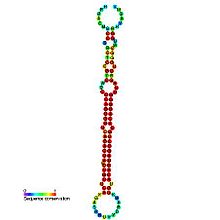- mir-199 microRNA precursor
-
mir-199 microRNA precursor 
Predicted secondary structure and sequence conservation of mir-199 Identifiers Symbol mir-199 Rfam RF00144 miRBase MI0000242 miRBase family MIPF0000040 Other data RNA type Gene; miRNA Domain(s) Eukaryota GO 0035195 0035068 SO 0001244 The miR-199 microRNA precursor (homologous to miR-215), is a short non-coding RNA gene involved in gene regulation. miR-192 and miR-215 have now been predicted or experimentally confirmed in mouse, human and a further 21 other species. [1] [2] [3] (MIPF0000040). microRNAs are transcribed as ~70 nucleotide precursors and subsequently processed by the Dicer enzyme to give a ~22 nucleotide product. The mature products are thought to have regulatory roles through complementarity to mRNA.[4]
Contents
Targets of miR-199
Using microarray and immunoblotting analyses it has been shown that miR-199a* targets the Met proto-oncogene.[5]
MicroRNA hsa-miR-199a is a regulator of IκB kinase-β (IKKβ) expression.[6]
Expression patterns of miR-199
Using TaqMan real-time quantitative PCR array methods, miRNA expression has been profiled. miR-199a, one of the most significantly overexpressed in invasive squamous cell carcinomas (ISCCs), was evaluated by transfecting cervical cancer cells (SiHa and ME-180) with anti-miR-199a oligonucleotides and the cell viability assessed. mirR-199a*, mir199a and mirR-199b were significantly overexpressed in ISCCs.[7]
Comparative miRNA array led to the isolation of several Bone Morphogenic Protein 2 (BMP2)-responsive miRNAs. Among them, miR-199a* is of particular interest, because it was reported to be specifically expressed in the skeletal system.[8]
Clinical relevance of miR-199
Alcoholic liver disease is a common medical consequence of chronic alcohol abuse. Activation of hypoxia-Inducible Factor-1α (HIF-1α) is an indicator of hypoxia. Endothelin-1 (ET-1) is a protein that constricts blood vessels and raises blood pressure. It has been shown that ethanol-induced miR-199 down-regulation may contribute to augmented HIF-1α and ET-1 expression.[9]
References
- ^ Lagos-Quintana M, Rauhut R, Meyer J, Borkhardt A, Tuschl T (2003). "New microRNAs from mouse and human". RNA 9 (2): 175–9. doi:10.1261/rna.2146903. PMC 1370382. PMID 12554859. http://www.pubmedcentral.nih.gov/articlerender.fcgi?tool=pmcentrez&artid=1370382.
- ^ Houbaviy HB, Murray MF, Sharp PA (2003). "Embryonic stem cell-specific MicroRNAs". Dev. Cell 5 (2): 351–8. doi:10.1016/S1534-5807(03)00227-2. PMID 12919684.
- ^ Dostie J, Mourelatos Z, Yang M, Sharma A, Dreyfuss G (2003). "Numerous microRNPs in neuronal cells containing novel microRNAs". RNA 9 (2): 180–6. doi:10.1261/rna.2141503. PMC 1370383. PMID 12554860. http://www.pubmedcentral.nih.gov/articlerender.fcgi?tool=pmcentrez&artid=1370383.
- ^ Ambros V (2001). "microRNAs: tiny regulators with great potential". Cell 107 (7): 823–6. doi:10.1016/S0092-8674(01)00616-X. PMID 11779458.
- ^ Kim S, Lee UJ, Kim MN, et al. (June 2008). "MicroRNA miR-199a* regulates the MET proto-oncogene and the downstream extracellular signal-regulated kinase 2 (ERK2)". J. Biol. Chem. 283 (26): 18158–66. doi:10.1074/jbc.M800186200. PMID 18456660.
- ^ Chen R, Alvero AB, Silasi DA, Kelly MG, Fest S, Visintin I, Leiser A, Schwartz PE, Rutherford T, Mor G (August 2008). "Regulation of IKKbeta by miR-199a affects NF-kappaB activity in ovarian cancer cells.". Oncogene 27 (34): 4712–4723. doi:10.1038/onc.2008.112. PMC 3041589. PMID 18408758. http://www.pubmedcentral.nih.gov/articlerender.fcgi?tool=pmcentrez&artid=3041589.
- ^ Lee JW, Choi CH, Choi JJ, Park YA, Kim SJ, Hwant SY, Kim WY, Kim TJ, Lee JH, Kim BG, Bae DS (2008). "Altered MicroRNA Expression in Cervical Carcinomas". Clin. Cancer Res. 14 (9): 2535–2542. doi:10.1158/1078-0432.CCR-07-1231. PMID 18451214.
- ^ Lin EA, Kong L, Bai XH, Luan Y, Liu CJ (2009). "miR-199a, a bone morphogenic protein 2-responsive MicroRNA, regulates chondrogenesis via direct targeting to Smad1.". J. Biol. Chem. 284 (17): 11326–11335. doi:10.1074/jbc.M807709200. PMC 2670138. PMID 19251704. http://www.pubmedcentral.nih.gov/articlerender.fcgi?tool=pmcentrez&artid=2670138.
- ^ Yeligar S, Tsukamoto H, Kalra VK (2009). "Ethanol-induced expression of ET-1 and ET-BR in liver sinusoidal endothelial cells and human endothelial cells involves hypoxia-inducible factor-1alpha and microrNA-199". J. Immunol. 183 (8): 5232–43. doi:10.4049/jimmunol.0901084. PMID 19783678.
Further reading
- Kalscheuer S, Zhang X, Zeng Y, Upadhyaya P (December 2008). "Differential expression of microRNAs in early-stage neoplastic transformation in the lungs of F344 rats chronically treated with the tobacco carcinogen 4-(methylnitrosamino)-1-(3-pyridyl)-1-butanone". Carcinogenesis 29 (12): 2394–9. doi:10.1093/carcin/bgn209. PMC 2722864. PMID 18780894. http://www.pubmedcentral.nih.gov/articlerender.fcgi?tool=pmcentrez&artid=2722864.
- Shen Q, Cicinnati VR, Zhang X, et al. (2010). "Role of microRNA-199a-5p and discoidin domain receptor 1 in human hepatocellular carcinoma invasion". Mol. Cancer 9 (1): 227. doi:10.1186/1476-4598-9-227. PMC 2939569. PMID 20799954. http://www.pubmedcentral.nih.gov/articlerender.fcgi?tool=pmcentrez&artid=2939569.
- Zhang GL, Li YX, Zheng SQ, Liu M, Li X, Tang H (August 2010). "Suppression of hepatitis B virus replication by microRNA-199a-3p and microRNA-210". Antiviral Res 88 (2): 169–75. doi:10.1016/j.antiviral.2010.08.008. PMID 20728471.
- Fornari F, Milazzo M, Chieco P, et al. (June 2010). "MiR-199a-3p regulates mTOR and c-Met to influence the doxorubicin sensitivity of human hepatocarcinoma cells". Cancer Res. 70 (12): 5184–93. doi:10.1158/0008-5472.CAN-10-0145. PMID 20501828.
External links
miRNA precursor families 1-100 101-200 201+ Other Categories:
Wikimedia Foundation. 2010.
